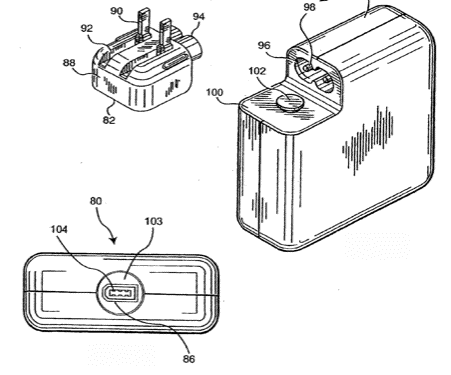Light Peak power patent

Intel and Apple are betting on Light Peak, a 10 GB/s fiber optic I/O system. But glass is a lousy conductor and it's handy if the I/O bus can carry power too. A newly published Apple patent application shows how they could do it.
The patent "Power Adapters For Powering And/Or Charging Peripheral Devices" was filed in July and published this month.
Written in dense, conceals-more-than-it-reveals legalese of high-priced patent lawyers, it requires digging to see how it applies to Light Peak. There are literally dozens of possible "embodiments" suggested by the patent, most of which are obvious prior art.
Key points Here are the key points from the patent, edited for clarity and bolding added:
The present invention relates to apparatus and methods for powering peripheral devices. More particularly, the present invention relates to improved techniques for powering and/or charging peripheral devices through a data transmission line.
Simple enough.
The invention pertains to power adapters that allow a user to power and/or charge a peripheral device . . . without requiring any additional cables or connectors. The invention also pertains to a connection method for powering a peripheral without requiring a host, peripheral or hub to remain powered on. The connection method allows peripherals to operate on buses that do not supply power.
"[B]uses that do not supply power" sums up optical rather nicely.
The Look
What might such a beast look like? No surprise here:

The power/data plug is on the bottom of Apple's standard white power adapter. Maybe we'll finally be able to replace the cable without buying the whole adapter.
The Storage Bits take Fiber optics are a wonderful data transmission medium: fast; robust; lightweight; and scalable through Wave Division Multiplexing (using several colors to move data in parallel). But consumers - Apple's main market - love the convenience of bus-powered peripherals.
Most peripherals - storage arrays, displays, most audio systems, scanner/copiers, printers and routers - are wall-powered and will stay that way. A simple fiber attach meets the need.
But there are many devices - most of them storage - that do rely on host power. Portable disk drives, flash drives, portable scanners, hubs, card readers and small audio devices have bus-powered versions available today.
And as power-saving technologies improve, there will be more devices that could be bus-powered, if there is power on the bus. Apple has 2 alternatives:
- Light Peak as a dock link, enabling powerful notebooks to morph into desktops through a single optical connector.
- Light Peak as a general-purpose high performance I/O channel for notebook computers.
Either is a big improvement over today's welter of slow and incompatible links. But Light Peak as a dock-enabler isn't very sexy. Even Steve's Reality Distortion Field won't put that over on the True Believers.
The second, more attractive, option requires power on the bus. What this patent shows is that Apple engineers, at least, are working to make that happen.
Comments welcome, of course.